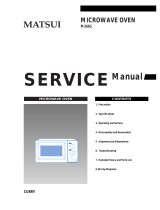
2. PRECAUTIONS ON INSTALLATION
(Figure 2)
A. Plug the power supply cord into a 120 V AC, 60 Hz,
single-phase power source with a capacity of at least 20
amperes.
B. Since the unit weights about 34 lbs, be sure to place it
on a sturdy and flat surface.
C. Avoid placing the unit in a location where there is direct
heat or splashing water.
D. Place the unit as far away as possible from TV, radio,
etc. to prevent interference. And do not place on or near
a hot gas or electric burner or in a heated oven.
CAUTION
3. GENERAL PRECAUTIONS IN USE
Microwave Oven
A. Never operate the unit when it is empty. Operating the
oven with no load may shorten the life of the magnetron.
Whenever cooking dry foods (dried fish, bread, etc.) or a
small amount of food, be sure to put a glass of water
into the cooking compartment. The turntable tray may
become hot after operating, be careful when touching it.
B. Aluminum foil should be avoided because it will disrupt
cooking and may cause arcing. However, small pieces
may be used to cover some parts of food to slow the
cooking. Any aluminum foil used should never be closer
than 2.5 cm to any side wall of the oven.
Toaster
A. Never operate the toaster when it is empty. Operating
the toaster with no load may overheat this appliance.
B. Oversized food, metal foil packages or utensils must not
be inserted in this toaster, as they may create a fire or
electrical hazards.
4. TRIAL OPERATION
After installation, the following sequences and results
should be checked carefully.
Microwave Oven
A. Put a container filled with water (about 1 liter) into the
oven, and close the door tightly.
B. Touch the STOP/CLEAR and the COOK TIME keys.
C. Set cooking time for 10 minutes by touching “1”
and then “0” three times. “1000” appears in the
display window.
D. Touch the START key.
Make sure the cavity light comes on. The unit will begin
cooking and the display window will show the time
counting down by seconds.
E. After about 5 minutes, make sure the primary interlock
switch, the secondary interlock switch and the interlock
monitor and oven lamp switch operate properly by
opening and closing the door several times. Touch the
START key each time the door is closed.
F. Continue operating the unit. Four long beep sound
signal is heard when the time is up. The unit will shut off
automatically.
G. Confirm the water is hot.
H. Finally, measure the output power according to
“POWER OUTPUT MEASUREMENT” on page 13.
Toaster
A. Make sure the crumb tray is pushed all the way in place
plugging in.
B. Remove all protective wrappings from food before
placing into toasting slots. Then place bread into slots
and close the door.
C. Select one mode(Toast/Bagel).
D. Press the Darkness Control to the desired setting.
E. Press the Start button. Make sure indicator light comes
on. The unit will begin cooking and the display will show
the browning level you selected.
F. After 1 minute, make sure the toaster door switch and
indicator light operate properly by opening and closing
the door several times (In normal state, indicator light
blinks when door is opened).
G. Continue operating the unit by pressing the Start button.
Beep sound signal is heard when the time is up. The
unit will shut off automatically and fan will blow for 1
minute to cool this toaster.
H. Confirm the bread is cooked.
NOTE : If you operate this toaster for the first time, you will
notice an odor, that is a characteristic of burning off
residues on the new heating elements. This is
normal.
-5-
This unit is equipped with a 3-prong plug for your safety.
If the wall outlet is a grounded 3-hole type, the unit will
be grounded automatically.
Three-Pronged(Grounding)
Plug
Figure 2
Properly Polarized and
Grounded
Outlet





















